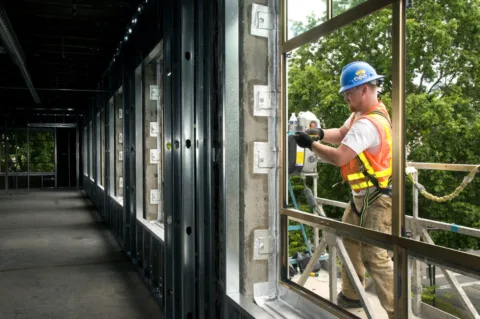If you live in a home where hurricanes occasionally roll through, you should take precautions to prepare your windows to take on the damaging winds and flying debris associated with hurricanes.
Every time a hurricane is about to make landfall somewhere along the Gulf coast or Atlantic seaboard, we see stories on the news of homeowners nailing plywood over their windows to protect them.
Sure, plywood is one way to protect your windows. But there are better methods and more technically advanced products that you can use to protect the windows of your home — if you live in a hurricane prone area.
There are 2 great ways to protect your windows against hurricane-force winds (other than plywood):
- Install hurricane shutters on all the windows — there are a few different kinds.
- Install high impact resistant glass windows — all throughout the home.
Today I’ll be giving you some helpful tips about hurricane impact resistant windows. Hopefully, you’ve read our article about hurricane shutters, too.
What Are Impact Resistant Windows?
Hurricane windows are not the same thing as impact resistant windows!
The term hurricane windows is a little misleading. The benefits of impact resistant windows exceeds just those homes located in areas prone to hurricanes. Impact windows also increase safety, noise reduction, and intrusion resistance. Burglars run once they try to smash one of these windows and realize that it is not going anywhere. Parents are not nervous when their small children play around a large picture window. And homeowners marvel just how much of the outside world’s noise no longer enters into the home. Impact windows are a great way to help reduce damage from severe thunderstorms that can have damaging wind. These types of storms can hit anywhere at any time. There is no replacing the peace of mind that a homeowner with impact windows goes to bed with.
~ Source
High impact windows are what you want — if you want your house to have a better chance of surviving a hurricane!
The most common way to achieve impact resistance in windows and doors is to select a product that uses laminated glass. “Laminated glass” is comprised of 2 panes of glass bonded together with a strong, clear interlayer. “Laminated insulating glass” is constructed as 2 panes of glass bonded together with a strong, clear interlayer — then includes an airspace followed by a third pane of glass for added insulation. The airspace between the 2nd and 3rd piece of glass is filled with air or other gas to reduce heat transfer.
~ Source
There are 2 main types of impact windows, depending on the degree of impact resistance (i.e. likelihood of shattering) you’re after:
- One type of impact windows is designed for small missile (projectile) impacts. These windows consist of multiple layers of polyvinyl butyral (PVB) sandwiched between 2 sheets of glass. The glass is then placed in an autoclave at least 600 degrees Celsius under high pressure — to temper the glass in order to increase its strength.
- The other type of impact windows is designed for larger missile impacts. These windows are referred to as PET laminated glass and glass-clad polycarbonate. In most cases, the windows are attached to the frame with structural silicone sealant.
Hurricane resistant windows or storm-proof windows are composed of impact resistant glass, containing a layer of polyvinyl butyral (PVB) between 2 slabs of glass. The most effective type of impact resistant window is the inner-membrane window. An impact-resistant glass will probably shatter on impact, but it will remain attached to the inner membrane along with the window frame. There is always the alternative of using a shatter-resistant film that covers window glass — that will prevent glass from shattering.
~ Source
Tips For Installing Hurricane Impact Resistant Windows
Before you have impact glass windows installed in your home, keep these important tips in mind:
- Impact resistant windows need to be paired with beefed up window frames — in order to provide sufficient protection from projectiles. The window frames may be constructed of wood, metal, vinyl, or a combination of materials. They have stiffeners and reinforcement to make them much stronger than typical window frames.
- If you’re retrofitting an existing window, it’s recommended that you replace the entire window system (frame and all) — in order for it to work as designed. Securing the window frame to the opening according to the manufacturer’s specifications is the key to keeping it intact under hurricane conditions.
Reasons To Install Impact Resistant Glass Windows
I can think of 2 good reasons that impact glass windows make the best hurricane windows:
- If one of your “regular” windows falls victim to a chunk of wood flying through it, the air pressure in your home will expand rapidly (much like a balloon) and something will give way — like this. It could be your roof, another window, a door, or even a wall. Once that happens, your home is extremely vulnerable and will quickly deteriorate with each passing minute. Hopefully, you and your loved ones will be out of harm’s way (inland) and not be around to witness the destruction — because it won’t be a pretty sight.
- Impact resistant glass windows have advanced to the point where they are thoroughly tested to withstand Category 5 wind conditions and the debris that goes with it. What that means is that your home has a much better chance of remaining intact with minimal damage!
Building Code Standards For Hurricane Impact Resistant Windows
Impact resistant glass windows must meet certain guidelines in order to be marketed and sold as such. The American Society for Testing & Materials (ASTM) has strict guidelines (E1886 and E1996) for hurricane impact resistant windows before they can be certified as impact resistant.
In south Florida, for instance, the building code states that all homes constructed after July 2001 must have hurricane shutters or impact resistant glass and window frames for exterior openings in a house to protect against wind-borne debris. (Codes for hurricane windows vary by community, of course.)
All impact resistant glass windows go through rigorous testing:
- The first test is called a large missile impact test. A 9-pound 2×4 wood stud is launched at 50 feet per second (fps), or almost 35 miles per hour, at the center of the window. If the window doesn’t shatter, another board is then shot at one of the corners of the window. Both the center and the corner of the window must be able to hold together to pass this test. Hurricane-prone Florida has slightly tougher testing standards, requiring windows to withstand boards launched at 80 fps.
- Then, the window is subjected to pressures that simulate winds of up to 200 miles per hour. If the window remains intact within the frame, it can be certified as an impact resistant window.
Here’s a short video illustrating the testing procedure for a large missile impact test procedure required by ASTM 1886-1996:
The window will be cycled thousands of times inward and outward at 1.5 times the design pressure to simulate actual Category 5 hurricane conditions — before being certified for sale as an impact resistant window.
Best Impact Resistant Hurricane Windows
As you may have guessed, there are many brands of impact resistant glass windows available that can withstand hurricane winds.
Most major window manufacturers have impact windows and doors in their product line these days.
Here are some of the best impact resistant hurricane windows:
- Andersen Stormwatch Coastal windows and doors
- Astor high impact windows and doors
- CGI Sentinel impact resistant windows and doors
- Kolbe impact certified windows and doors
- Marvin Integrity windows and doors
- Pella HurricaneShield impact glass windows
- PGT Winguard impact resistant windows
- Weather Shield hurricane impact windows and doors
TIP: Be sure to look for products certified to meet large missile impact level D, and wind zone 4 testing standards when you’re buying hurricane windows for your home.
-> Here’s how to tell if you have impact resistant hurricane windows or not.
How Much Do Hurricane Windows Cost?
The price for hurricane windows varies greatly depending on where you live, how many windows you’re installing, the size of those windows, the type of those windows, and whether or not your installing impact resistant glass doors at the same time.
Believe it or not, hurricane impact resistant windows generally cost less than other options. See why.
A good hurricane window cost will be between $40 and $55 a square foot, and this will include the frame and the hurricane-proof glass. Some studies have shown that by installing hurricane windows, the construction cost will be increased only by a few thousand dollars on a new home. As an average, a hurricane impact door size 60″x80″ can cost about $1,900 while a sliding window 72″x80″ is around $1950. A single hung window cost is between $500 and $600, material only.
~ Source
Use these helpful guides to get a ballpark figure for installing storm windows vs. installing standard windows.
While storm windows are stronger and more durable than standard house windows, clearly storm windows aren’t impact-resistant like hurricane windows are. Keep that in mind when comparing prices.
Finally, compare those window prices with the cost to install hurricane shutters.






